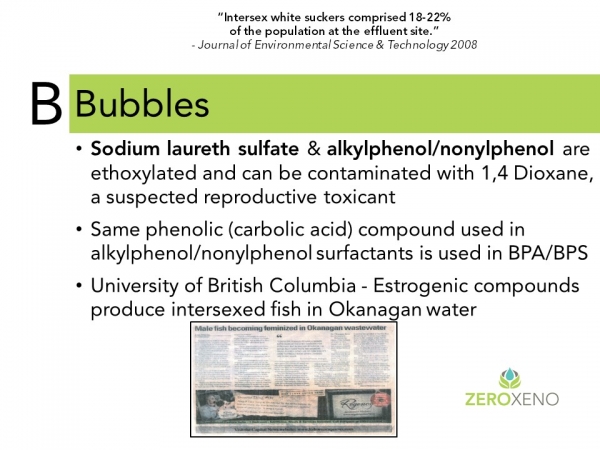Our products are proudly manufactured in Canada and are a product of Canada.
The 7 Deadly Estro-Sins: Bubbles
January 06, 2020

Are you ready to begin your journey and learn about the dangers xenoestrogens pose to you and your family? By learning my acronym the 'BSFACTS' you will understand how to avoid the various dangers associated with bubbles, including their potential estrogenic effect.
B Is For Bubbles
What is so bad about bubbles you say? Bubbles are great fun for kids and provide luxurious bathing experiences, but unfortunately they may come at a cost to your body's hormone balance.
Did you know that many of the products you use daily to shower or bath with are made from the same chemical ingredients found in industrial cleaning agents? Sodium lauryl/laureth sulfate (SLS/SLES) and alkylphenol, nonylphenol and octylphenol surfactants are so effective at removing oil and dirt from greasy car engines that companies who make personal care products decided they should be used to clean your hair and skin too. Not really sure about the logic here but I guess it made sense to someone at the time.
Be Wary of Bubbles
SLS/SLES are foaming agents that create long lasting bubbles in shampoo, body wash and hand soap. Unfortunately many people today associate bubbles with cleanliness, which is not really the truth. SLS/SLES surfactants are also present in other types of personal care items, including baby products that claim to be 'sensitive' or 'gentle'. Some scientists believe that SLS/SLES and other surfactants pose various health hazards that include eye damage in children and skin irritation.
Some surfactants used in personal care products, including baby shampoo, are put through the ethoxylated process which creates 1,4-dioxane, a known toxic, carcinogenic by-product and suspected reproductive toxicant. The Environmental Protection Agency (EPA) has declared 1,4-dioxane as an emerging contaminate as it's perceived as a potential health hazard to human health and the environment. There are various dangers associated with 1,4-dioxane which include cancer, miscarriage and stillbirths.
At the University of British Columbia, scientists have discovered estrogenic compounds that mimic female hormones in male fish which can produce intersexed fish. Many surfactants used in finished cosmetic products today have estrogenic effects on fish because of their alkylphenol, nonylphenol and octylphenol content.
Are all Bubbles Bad?
Let’s spend a moment to get a clearer picture of the dangers of certain bubbles because not all bubbles are bad. Old fashioned Castile soap will bubble and lather nicely and is a safe product for use on your body. You may know Castile soap as the type your grandma used in her home to keep everyone and everything clean.
Products that bubble excessively, like bubble bath are usually made with surfactants that represent the potentially dangerous type of bubbles due to their estrogenic effect. To help you understand more clearly what type of bubbles are safe and which ones are not, one needs to understand the difference between good and bad bubbles.
Science of Bubbles
The best way to distinguish good bubbles from bad ones is actually pretty simple but it does require a mini science lesson. Safe bubbles are short lived due to the high surface tension of water and instability of their bubble structure. In other words, they form and they pop. Ethoxylated surfactants significantly reduce the surface tension of water which allows for the creation of a stable, longer lasting bubble. You know the kind of micro-bubbles that turn into excessive foam which seem to unnaturally last forever!
Now you can easily recognize the bad type of bubbles because they create mountains of foamy bubbles that go on and on. Anyone who has added bubble bath to a jetted bathtub can attest to this fact!
Estrogenic Effect
The estrogenic effect of some ethoxylated surfactants are linked to breast cancer which is potentially caused by the phenol (carbolic acid) that is incorporated during the manufacturing of alkylphenol and nonylphenol surfactants. It is interesting that this same phenol is utilized in the manufacturing process of the estrogenic chemical bisphenol A (BPA) which is used to harden polycarbonate plastic water bottles. In case you were wondering, the single largest market for phenol is in the production of BPA, which is manufactured from phenol and acetone (also known as nail polish remover).
The 'Green Washing' Game
I recommend you read my blog on sodium coco sulfate (SCS). Some manufacturers claim SCS is a gentler alternative to SLS/SLES but is this the truth or have you just been 'Green Washed'? SCS is manufactured using some but not all of the same basic chemical process as SLS/SLES. SCS has a different name than SLS/SLES mainly because when it's produced the manufacturer uses a blend of fatty acids instead of just one fatty acid.
Remember, avoiding hormone disrupting personal care products is the best choice for you and your loved ones. Choose products that provide a nice lather and a gentle clean and avoid those that create never-ending foamy bubbles.
Join The Zero Xeno Movement today!
by Bonnie Penner
All Zero Xeno (ZX Enterprises Inc.) products are for external use only. All advice and information posted on this website is from personal research and/or experience and is intended for general educational purposes. Our intent is not to diagnose, treat, cure or prevent any disease. The information on our site is not intended to be a substitute for professional medical advice related to specific medical conditions. We cannot diagnose illnesses nor confirm any claim as to therapeutic safety, effectiveness or course of treatment. Always seek the advice of your physician or other qualified health professionals for any concerns regarding your health. Only your physician can provide specific diagnosis and treatments. Please refer to our full Disclaimer for more details.



